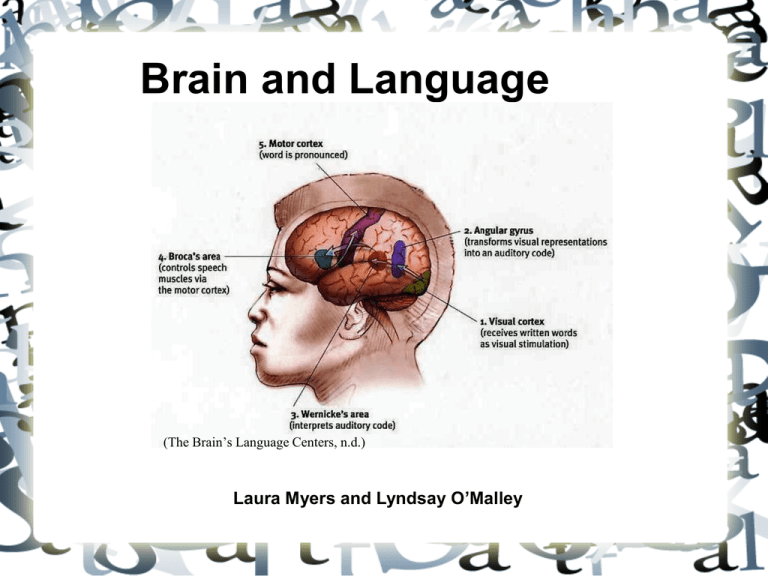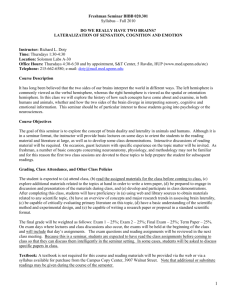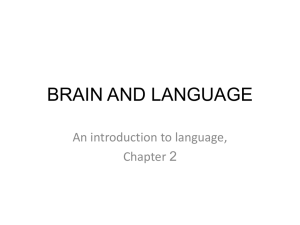
Brain and Language
(The Brain’s Language Centers, n.d.)
Laura Myers and Lyndsay O’Malley
Exercise 5
What are the arguments and evidence that have been
put forth to support the notion that there are two
separate parts of the brain?
Argument 1: Functions of the brain are
localized.
Evidence:
(Wernicke’s Area, n.d.)
- Damage to Broca's area, the inferior frontal gyrus
of the left hemisphere, results in the inability to
follow the rules of syntax and the production of
agrammatic language.
- Damage to Wernicke's area produces semantically
incoherent language, for example trouble naming
objects and producing lexical errors.
More Evidence
- Deaf aphasics also show deficits in the same areas
of the brain as hearing aphasics, even though they
are signing rather than speaking.
- Left hemisphere damaged Japanese are unable to
understand Kana, the sound system-based
language, and right hemisphere damaged Japanese
are unable to read Kanji, the ideographic-based
language.
(Small Talk aphasia, n.d.)
Argument 2: Brain imaging technology
allows us to identify parts of the brain and
their correlation to cognitive tasks.
Evidence:
Magnetic encephalography (MEG) allows us to
measure activity of the living brain and reaction to
certain stimuli.
Comparisons of fMRI of brain lesion patients and
PET scans of normal patients showed that the
lesions in fMRI patients, who had specific
linguistic deficits, corresponded exactly to the
functioning areas of the PET patients, who were
able to perform the tasks that the fMRI patients
could not.
Argument 3: The left hemisphere is
predetermined to develop language in
very young children.
Evidence:
- Babies expressing language-like sounds open the
right side of their mouths more than the left side,
indicating greater activity in the left hemisphere.
- If the left brain has been removed the right brain
will compensate for the missing brain functions,
but a child undergoing a right hemispherectomy
before the age of two generally does not develop
language.
Argument 4: The corpus callosum is the
connection between the left and right
hemispheres of the brain.
Evidence:
When the brain is surgically split, the two
hemispheres cannot communicate. For example,
when a patient is given an object in the left hand
he or she can sense the object but cannot describe
it because the information cannot be sent from the
right brain to the left, where the language cortex is
located.
Argument 4 Evidence, Continued
Split-brain operations show that the two hemispheres
have different strengths. The right hemisphere is
more visually oriented: it is superior in pattern
matching tasks, recognizing faces, and in spatial
tasks. The left brain is more abstract in
orientation: it is stronger in language, rhythmic
perception, temporal-order judgments, and
arithmetic calculations.
Argument 5: There are several
experimental evidences of brain
organization.
Evidence:
Dichotic listening allows researchers to study the
effects of linguistic sounds and non-linguistic
sounds on the brain and how the brain processes
these sounds. Evidence shows that the left
hemisphere processes linguistic sounds and the
right hemisphere processes non-linguistic sounds,
thus showing strong lateralization of the brain.
Argument 5 Evidence, Continued
Event-related brain potentials (ERP) allow scientists
to study how quickly the brain processes language
and the area it is being processed in. It also shows
how strongly the brain responds to the stimulus
and the variations in timing, pattern, and amplitude
of the evoked potentials.
Questions about Exercise 5?
Research Article 1: Brain Connectivity:
Gender Makes a Difference
Neuroimaging has recently proven that male and
female brains are different, therefore connectivity
differs between genders. When an experiment or
test is taking place on the brain, gender should be
taken into consideration. However, it generally is
not.
Research Article 2: Sex Differences in
Dichotic Listening
This meta-analysis examined the magnitude of
difference in perceptual asymmetries between
male and female subjects found in dichotic
listening studies. Using statistical analysis of 595
effect sizes, it found a significant, homogeneous,
but small difference in auditory specialization of
tasks (lateralization) between sexes, in that men
are slightly more lateralized than women. For both
sexes, this laterality is greater for verbal than nonverbal tasks.
Pertinence to Chapter 2, Brain and Language
This study provides confirmation that dichotic
listening is a valid tool to investigate cerebral
lateralization, so we can accept the section on
dichotic listening.
It also confirms that lateralization is considered a
fact in the scientific community.
Finding greater laterality in verbal than non-verbal
tasks is interesting.
Additional Thoughts: LeftBrain/Right Brain Pseudo-Science
Evidence of laterality in the brain has led to the idea
that the right brain is more creative and the left
brain is more logical. This idea is not supported by
the scientific community at all. The evidence
points to both sides having a role to play in
cognitive tasks, but their roles differ. (Clark, 2007;
Hemispheric dominance, n.d.; Taylor, 2009)
Left-brain Right brain game
Discussion Questions
1. Could lateralization have an evolutionary
purpose?
2. Is the brain differentiated between genders? If so,
how?
3. Why is the brain more lateralized for verbal than
non-verbal tasks?
4. How could one use the material covered in the
chapter to combat the idea of right-brain/leftbrain hemispheric dominance?
References
Clark, D. 2007. Left brain Right brain – a myth. Donald Clark Plan B. Retrieved from
http://donaldclarkplanb.blogspot.com/2007/06/left-brain-right-brain-myth.html
Gong, G., He, Y., & Evans, M. C. (2011). Brain connectivity: Gender makes a
difference. The Neuroscientist, 17(5), 575-591. doi:
10.1177/1073858410386492
Hemispheric Dominance. n.d. Rational Wiki. Retrieved from
http://rationalwiki.org/wiki/Hemispheric_dominance May 1, 2012
Small Talk aphasia. (n.d.). Retrieved from
http://www.macworld.com/appguide/app.html?id=80138&expand=false April
30, 2012.
Taylor, D. H. (2009). Modern myths of learning: the creative right brain. Donald H.
Taylor. Retrieved from http://donaldhtaylor.wordpress.com/writing/modernmyths-of-learning-the-creative-right-brain May 1, 2012
References, Continued
The Brain’s Language Centers. (n.d.). Retrieved from
http://www.rhsmpsychology.com/Handouts/brain_and_language.htm April 30,
2012.
Voyer, D. (2011). Sex differences in dichotic listening. Brain and Cognition, 76(2),
245-255. doi: 10.1016/j.bandc.2011.02.001
Wernicke’s Area. (n.d.). Wikipedia. Retrieved from
http://en.wikipedia.org/wiki/Wernicke%27s_area April 30, 2012.




![Wernicke`s_area_presentation[1] (Cipryana Mack)](http://s2.studylib.net/store/data/005312943_1-7f44a63b1f3c5107424c89eb65857143-300x300.png)







